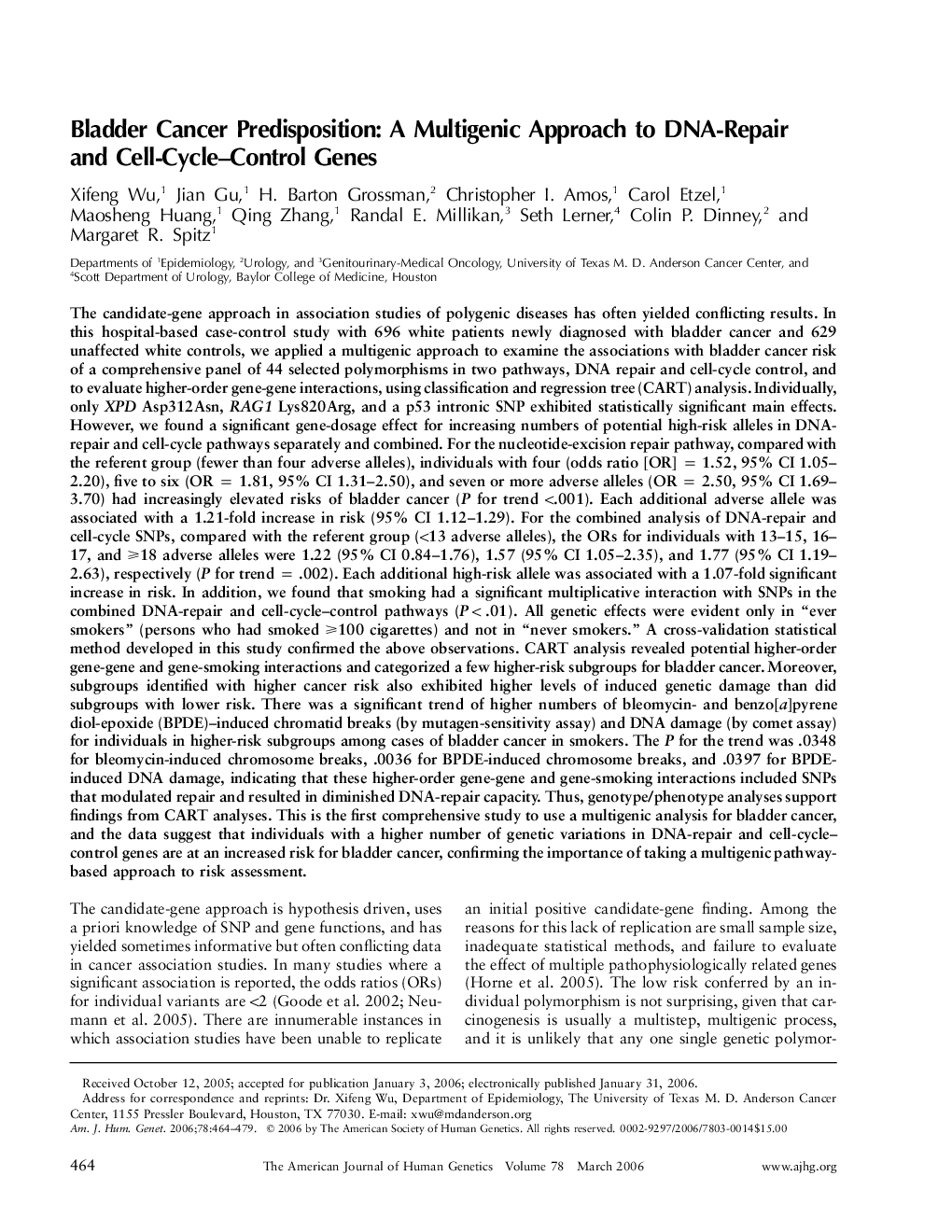| کد مقاله | کد نشریه | سال انتشار | مقاله انگلیسی | نسخه تمام متن |
|---|---|---|---|---|
| 2812529 | 1569312 | 2006 | 16 صفحه PDF | دانلود رایگان |

The candidate-gene approach in association studies of polygenic diseases has often yielded conflicting results. In this hospital-based case-control study with 696 white patients newly diagnosed with bladder cancer and 629 unaffected white controls, we applied a multigenic approach to examine the associations with bladder cancer risk of a comprehensive panel of 44 selected polymorphisms in two pathways, DNA repair and cell-cycle control, and to evaluate higher-order gene-gene interactions, using classification and regression tree (CART) analysis. Individually, only XPD Asp312Asn, RAG1 Lys820Arg, and a p53 intronic SNP exhibited statistically significant main effects. However, we found a significant gene-dosage effect for increasing numbers of potential high-risk alleles in DNA-repair and cell-cycle pathways separately and combined. For the nucleotide-excision repair pathway, compared with the referent group (fewer than four adverse alleles), individuals with four (odds ratio [OR] = 1.52, 95% CI 1.05–2.20), five to six (OR = 1.81, 95% CI 1.31–2.50), and seven or more adverse alleles (OR = 2.50, 95% CI 1.69–3.70) had increasingly elevated risks of bladder cancer (P for trend <.001). Each additional adverse allele was associated with a 1.21-fold increase in risk (95% CI 1.12–1.29). For the combined analysis of DNA-repair and cell-cycle SNPs, compared with the referent group (<13 adverse alleles), the ORs for individuals with 13–15, 16–17, and ⩾18 adverse alleles were 1.22 (95% CI 0.84–1.76), 1.57 (95% CI 1.05–2.35), and 1.77 (95% CI 1.19–2.63), respectively (P for trend = .002). Each additional high-risk allele was associated with a 1.07-fold significant increase in risk. In addition, we found that smoking had a significant multiplicative interaction with SNPs in the combined DNA-repair and cell-cycle–control pathways (P<.01). All genetic effects were evident only in “ever smokers” (persons who had smoked ⩾100 cigarettes) and not in “never smokers.” A cross-validation statistical method developed in this study confirmed the above observations. CART analysis revealed potential higher-order gene-gene and gene-smoking interactions and categorized a few higher-risk subgroups for bladder cancer. Moreover, subgroups identified with higher cancer risk also exhibited higher levels of induced genetic damage than did subgroups with lower risk. There was a significant trend of higher numbers of bleomycin- and benzo[a]pyrene diol-epoxide (BPDE)–induced chromatid breaks (by mutagen-sensitivity assay) and DNA damage (by comet assay) for individuals in higher-risk subgroups among cases of bladder cancer in smokers. The P for the trend was .0348 for bleomycin-induced chromosome breaks, .0036 for BPDE-induced chromosome breaks, and .0397 for BPDE-induced DNA damage, indicating that these higher-order gene-gene and gene-smoking interactions included SNPs that modulated repair and resulted in diminished DNA-repair capacity. Thus, genotype/phenotype analyses support findings from CART analyses. This is the first comprehensive study to use a multigenic analysis for bladder cancer, and the data suggest that individuals with a higher number of genetic variations in DNA-repair and cell-cycle–control genes are at an increased risk for bladder cancer, confirming the importance of taking a multigenic pathway-based approach to risk assessment.
Journal: - Volume 78, Issue 3, March 2006, Pages 464–479